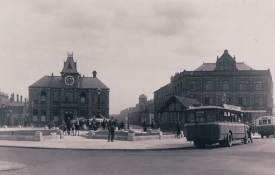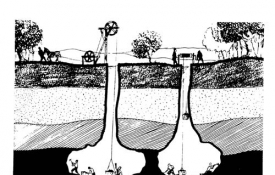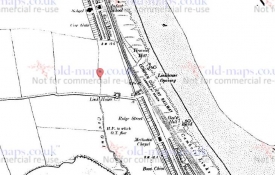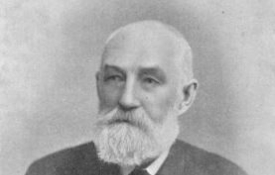Welcome to the Community View section of the website. This area is dedicated to articles of interest, community information and local topics that are submitted by members of the public or guest writers. It is also the main section dedicated to the Youth Media Group Project.
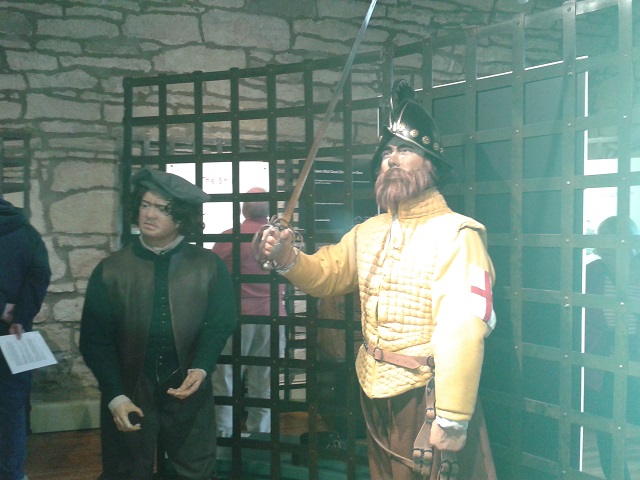
Wallace in his history of Blyth 1862 describes how in 1552 the gentry of SE Northumberland collaborated to plan measures of defence against the border reivers of the more lawless parts of Northumberland of Tynedale and Redesdale, near the border with Scotland.
A clan society had built up in these areas where the residents had developed an allegiance to their surname rather that their country or monarch. They lived by plundering and extortion and their raids often came deep into SE Northumberland.
Much has been written of this unique society and for further research Tom Moss' website www.reivershistory.co.uk will probably answer all your questions and provide inspiration for heritage trails. The DVD "The Reivers and the Making of the Borders" by Alistair Mofatt and Fiona Armstrong is entertaining, and Hexham Old Gaol Museum is a must visit. I visited recently and took these pics as well as conducting a short heritage trail round the Debateable Lands in search of my Little ancestors who were allied with the Armstrongs.
.png)
.jpg)
This is what Wallace wrote:
"Blyth Nook is mentioned in an old border law, 1552, which enjoined that Shotton-dyke-nook should be watched nightly by two men, inhabitants of Shotton and Hartford; another watch to be kept at the north side of the Down-hill, with two men of Horton and Bebside; and the watch at Lorakin-hill to be kept by two men of Blyth Nook and Cowpen. The first two places directed to be watched still retain their names ; but we have no guide to Lorakin-hill. Indeed there does not seem to be a place in either the township of Cowpen or Newsham that can be called a hill, unless it refers to some of the sand hills. George Morton was setter and searcher of the three watches, and Liall Fenwick and John Bell overseers.
The object of the watches at Shotton and Down-hill was evidently to prevent the thieves getting into the country on the south of the Blyth, a district well stocked with cattle, and for that reason very liable to a visit from the freebooters. Bedlington being an important town, that circumstance, in conjunction with the absence of fords, would render it a rather dangerous experiment to cross that part part of the river; but by making a detour through Bedlingtonshire, by the south of the Wansbeck, and coming along the links, they, at the right time of people in the western part of this county continued for many generations to live by plundering their neighbours, and that all the power of the government was unable to destroy the evil. But so it was.
This state of things continued so long, and operated so injuriously in retarding the improvement and prosperity of this part of the country, that it really demands more than a mere passing allusion, and unfortunately there is no lack of materials for this purpose. It were easy to fill volumes from the most authentic sources, but it will suffice for our present object to adduce a few facts illustrative of the state of affairs at the period referred to. In a letter written to Cardinal Wolseley, then Bishop of Durham, by the Bishop of Carlisle, dated Newcastle, 17th of June, 1522, he says, "the Lord Ross, Sir "William Paxton, Sir Richard Ellercar, and Sir Richard Tempest, departed from Newcastle this morning with five hundred men to Alnwick, where the Lord Dacre meets them. The Scotch under the Duke of Albany, we hear, are coming to the borders, but there is more theft, more extortion, by the English thieves, than there is by all the Scots in Scotland. There is no man, that does not abide in a stronghold, that hath any cattle or moveables in security throughout the bishopric, and from the bishopric till we come within eight miles of Carlisle. the bishopric till we come within eight miles of Carlisle. And all Northumberland likewise, Hexhamshire worst of all, for in Hexham itself, every market day, there come fourscore or a hundred thieves, and the poor man and the gentleman too seeth their goods, and the men that did rob them, but dare not complain of them by name, nor say one word to them. The thieves take all their cattle and horses, and their corn as they carry it to sow or to the mill to grind. And at their houses they bid them deliver what they have, or they will be fired and burnt. By these proceedings not being looked to all the country goeth to waste. We want, for the borders about Carlisle, one thousand bows and as many sheaves of arrows."
In a book written by Grey, called a Survey of Newcastle, 1549, speaking of the borderers, he says, " There are many dales, the chief of which are Tynedale and Redesdale, a country that William the Conqueror did not subdue, retaining to this day their ancient laws and customs. These highlanders are famous for thieving ; they are all bred up and live by theft ; they come down from these dales to the low country, and carry away horses and cattle so cunningly that it will be hard for any to get them or their cattle, except they be acquainted with some master thief, who for some money may help them to their stolen goods." He adds, " there are many of them brought to the gaol at Newcastle, and at the assizes are condemned and hanged, sometimes to the number of twenty or thirty at a time." So that we are not to suppose that the authorities took no measures to repress those disorders ; various means were used, but without any permanent result. In 1524 Lord Surrey sent Sir Ralph Fenwick with eighty horsemen not to suppose that the authorities took no measures to repress those disorders ; various means were used, but without any permanent result. In 1524 Lord Surrey sent Sir Ralph Fenwick with eighty horsemen into Tynedale, to apprehend Will Ridley, a noted chief of the freebooters; but Will Charlton, another master thief, hearing that Sir Ralph had come into the dale, hastily gathered his followers, of whom it is said he had two hundred, who were bound and sworn upon a book.
The watches thus appointed were a portion of a scheme of defence against the moss-troopers, that was devised by. a commission appointed for the purpose, the articles of which were afterwards agreed to and signed by all the people of rank, property, and influence in the county.
The measures of defence which they entered into a formal agreement to adopt throw considerable light upon the state of the county at that period. The lands were all open and unenclosed. This was considered to afford great facilities to the borderers in carrying out their depredations. The aspect of the country then must have differed widely from its present one. In the midst of moor-lands or extensive woods, there was every here-and-there the large open pasture and cultivated fields of the village; instead of each farmer's land lying altogether as at present they were all intermixed. There was one large cultivated field, where each tenant held his own portion of arable land, under the name of "ox- gangs" these were without hedge or any division, save a strip of grass which bordered each tenant's holding, and beyond that was the pasture where the cattle fed in common under the charge of the village herd. The first measure they devised was to defend the towns villages, &c, by enclosing the adjoining lands and dividing them into small closes or crofts of not more than two acres each. The roads were to be made narrow and crooked that the enemy may be met at corners, where a few men may be able to resist and annoy them by the bow. The enclosure to be well defended by a ditch four feet deep and six feet broad, and planted with a double quickset hedge and some ashes. The second thing to be done was that all the town fields for tillage, meadows, and pasture, were to be severed from each other, so that every owner or farmer's land was to lay together, and hedged and ditched in like manner. After these there were directions for enclosing commons and repairing castles, and the agreement is followed by a schedule of all the lords, freeholders, &c., in the county, that have agreed to the execution of the articles, which state, " such of them as can write have hereunto subscribed their names ; and such other as cannot write have hereunto set their mark, and caused their names hereafter to be written."
And of the one hundred and forty-six persons of rank, and property, and influence, who signed the above document, only fifty-four could write their names. Among those who could not write their names were John Ogle, of Newsham, and his son-in-law, Lancelot Cramlington, of Blyth Nook. Now, when John Ogle could not write — whose father was a knight, and his mother a Delaval — what would be the state of education among the poor?"
It seems the watch was not always kept as diligently as had been hoped. This piece is from the Northumberland County History citing the Seaton Delaval manorial court records:
"Provision was made for watch and ward. The Prior's Banks, a locality probably to be found near the village of Holywell, where the main road crosses the Seaton Burn, were watched nightly by two of the inhabitants of Seaton Delaval, Newsham and Holywell. The tenants were obliged, by order of the lord of the manor, to keep horse and armour and be in readiness to serve their sovereign in the field; but how inadequate was the sanction provided in the petty fines of the manorial court is shown by the following instructive entry in the Seaton Delaval Rolls.
1582. Memorandum that it was inquired by the steward of this court this 7th of May in the 24th year of majesty Elizabeth, of Matthew Ladley and Thomas Matland of Holywell whether 10 shillings were too grievous an amercement (fine) to pay for default of not keeping an able horse and furniture etc. but they would make no answer thereto, but only that it was lawful for the lord of the manor of Seaton Delaval to make the amercement at his pleasure. And the like question being demanded of John Hall a freeholder there in Holywell, and of John Read an inhabitant there and tenant, and th'eires of one James Bayle also a freeholder there, they answered that if they would be excused at the lord's hand of the said manor for the payment of 10 shillings for their default in not keeping able horse and furniture etc they would not be at charges with the keeping of a good horse for her majesties service, but had rather pay the 10 shillings than keep an able horse." [In other words the fine was less expensive than providing the watch service required of the residents.]
Was there any evidence of these means of defence like the twisty narrow lanes, mentioned by Wallace, around the Blyth Valley area, despite the lands having been developed and the open fields enclosed into the farms we can see today, and the length of elapsed time? A contender could be the ancient and largely unused Hathery Lane which runs between Horton and Bebside, which has lots of twists and turns. But a study of old mapping indicates that the road follows the boundary line between Cowpen and Bebside townships and this could be the reason for the course of the road.
| Hathery Lane Bebside |
| Beacon Lane to the West of Cramlington |
But Beacon Lane in Cramlington could be a stronger contender. This is no longer used for major vehicular traffic and is no more than a path. Not only does it have some inexplicable sharp bends but the beacon in its name is possibly a clue to its importance in the 16th century. A chain of beacons were lit at various locations to warn of impending raids. The beacon at the top of Capheaton Castle, near the source of the River Blyth, is well documented. Less well known is a cairn which carried a beacon at Higham Dykes, near Belsay. Beside Beacon Lane is a cropmark indicating an archaological feature which has so far been unexplored. Could it be the foundations for a structure carrying a beacon? There does not seem to be any evidence of enclosure of the open fields at this time into the two acre fields as recommended. Hartley was enclosed in the 1570s but this appears to be down to the Delaval landholders wanting to convert to the more profitable sheep farming rather than as a measure of defence. Cowpen township was not divided into individual holdings until 1619.
Best Wishes
Alan
Used to live is Sussex Street down by the Quay. I went back just this week and was quite shocked at how much has changed. But 60 years does that!
For Reiving Arms and Armour, and more, try my blog Falling Angels, Lost Highways blogspot
over 120 postings... but for some of the "reiving pieces" you will have to scroll down to the earlier postings.
We used to run the Museum of Border Arms and Armour, and contributed to the "Edwins Kingdom" DVD, as well as the "Osprey" Men at Arms book "The Border Reivers."
All the Best,
Brian Moffatt.
